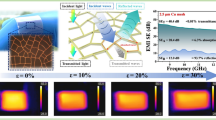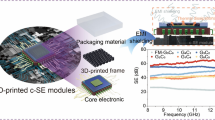Abstract
We have developed very flexible and lightweight LED-embedded ribbons in which LED-mounted printed circuit board (PCB) pieces are mounted and soldered to ribbons with the copper wires of power lines to apply them to the complicated three dimensional shapes of ceilings, walls, and furniture in rooms and provide higher levels of safety during earthquakes. Since it has been difficult to integrate LEDs in flexible ribbons and not only mount them on flat substrates but on bendable ribbons, we developed a new structure for LED-embedded ribbons and their fabrication process using a reel to reel mounting machine. A 2-cm wide ribbon with copper power lines on both sides was first constructed for the fabrication process of LED-mounted ribbons and then 5 × 20 mm LED mounted PCB pieces were mounted and soldered to the power lines of the ribbon. The ribbon was pulled under an optimal tension of 3.16 N to flatten the ribbon in the mounting process and the PCB pieces were pushed onto the ribbon with a rib height of 5 mm to strongly connect the pieces to the ribbon. The LED-embedded ribbon we constructed was 1.2 m long and very lightweight because it only weighed 7 g/m. The fabricated device had enough luminance of 96 lx for home and office lighting and could be installed on complicated surfaces such as adhering it to ceilings and the edges between ceilings and walls because our LED ribbon could be bent to a diameter of 5 mm. Our LED-embedded ribbon structure and assembly tool should provide new types of highly bendable and light-weight lighting for complicated three dimensional surfaces and safety during earthquakes.








Similar content being viewed by others
References
Ayob M, Kendall G (2008) A survey of surface mount device placement machine optimization: machine classification. Eur J Oper Res 186:893–914
Ayob M, Kendall G (2009) The optimisation of the single surface mount device placement machine in printed circuit board assembly: a survey. Int J Syst Sci 40:553–569
Branas C, Azcondo F, Alonso J (2013) Solid-state lighting: a system review. IEEE Industrial electronic magazine 7:6–14
Castano L, Flatau A (2014) Smart fabric sensors and e-textile technologies: review. Smart Mater Struct 23:053001
Cherenack K, Pieterson L (2012) Smart Textiles: challenges and opportunities. J Appl Phys 112:091301
Fraser S, Raby A, Pomonis A, Goda K, Chian SC, Macabuag J, Offord M, Saito K, Sammonds P (2013) Tsunami damage to coastal defences and buildings in the March 11th 2011 Mw 9.0 Great East Japan earthquake and tsunami. Bull Earthq Eng 11:205–239
Harold P (2006) Creating a magic lighting experience with textiles. Philips Password Magazine, 28:6–11
Magliulo G, Pentangelo V, Maddaloni G, Capozzi V, Petrone C, Lopez P, Talamonti R, Manfredi G (2012) Shake table tests for seismic assessment of suspended continuous ceilings. Bull Earthq Eng 10:1819–1832
Maxfield C (2008) Bebop to the Boolean Bogie. Newnes
Motosaka M, Mitsuji K (2012) Building damage during the 2011 off the Pacific coast of Tohoku earthquake. Soils Found 52:929–944
Sing Chan Y, Lee S (2011) Spacing optimization of high power LED arrays for solid state lighting. J Semicond 32:014005
Takamatsu S, Yamashita T, Itoh T (2014a) Meter-scale large area LED-embedded light fabric for the application of fabric ceilings in rooms. Microsyst Technol. doi:10.1007/s00542-014-2174-z
Takamatsu S, Yamashita T, Murakami T, Masuda A, Itoh T (2014b) Weaving of fabric for meter-scale floor touch sensors using automatic looming machine. Sens Mater 26:559–570
Takewaki I, Murakami S, Fujita K, Yoshitomi S, Tsuji M (2011) The 2011 off the Pacific coast of Tohoku earthquake and response of high-rise buildings under long-period ground motions. Soil Dyn Earthq Eng 31:1511–1528
Acknowledgments
This research was conducted as an undertaking of the New Energy and Industrial Technology Development Organization (NEDO) project entitled “Development of Manufacturing Technologies for Hetero-Functional Integrated Devices” (BEANS project).
Author information
Authors and Affiliations
Corresponding author
Rights and permissions
About this article
Cite this article
Takamatsu, S., Yamashita, T., Murakami, T. et al. Fabrication and evaluation of LED-embedded ribbons for highly flexible lighting applications in rooms. Microsyst Technol 22, 1079–1087 (2016). https://doi.org/10.1007/s00542-015-2467-x
Received:
Accepted:
Published:
Issue Date:
DOI: https://doi.org/10.1007/s00542-015-2467-x




